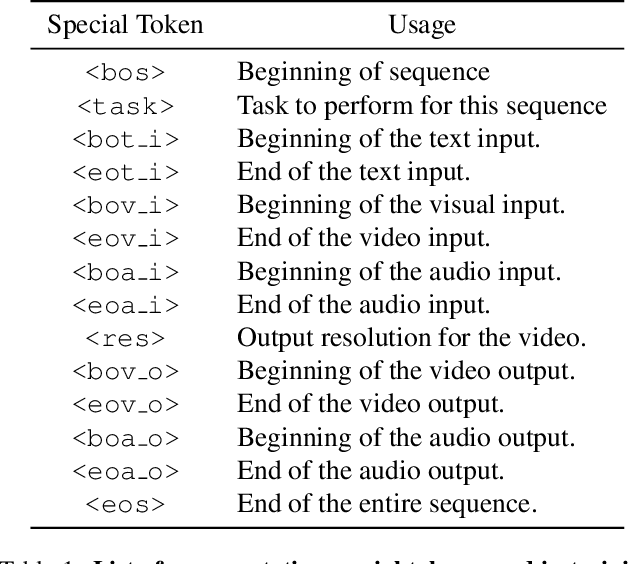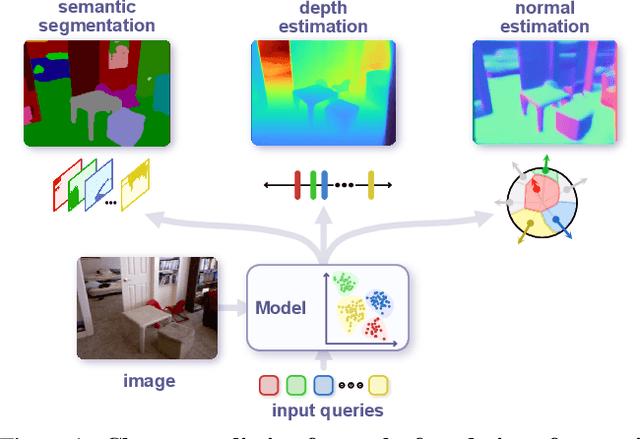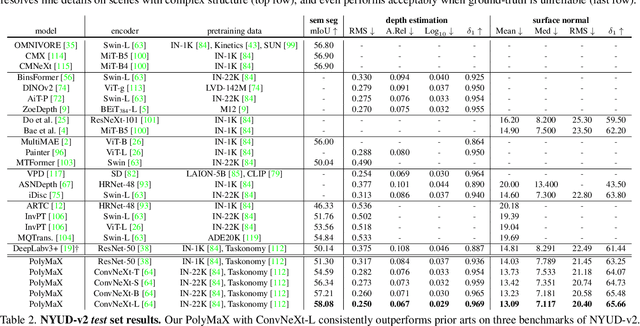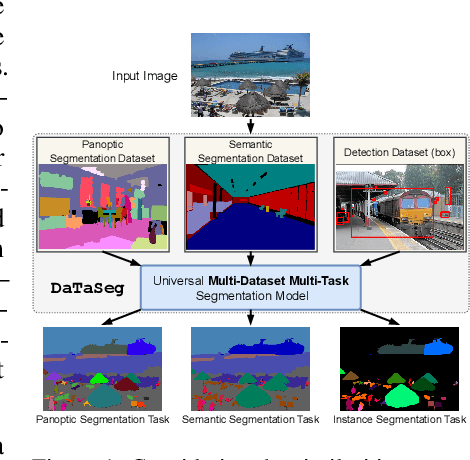Xiuye Gu
VoCap: Video Object Captioning and Segmentation from Any Prompt
Aug 29, 2025Abstract:Understanding objects in videos in terms of fine-grained localization masks and detailed semantic properties is a fundamental task in video understanding. In this paper, we propose VoCap, a flexible video model that consumes a video and a prompt of various modalities (text, box or mask), and produces a spatio-temporal masklet with a corresponding object-centric caption. As such our model addresses simultaneously the tasks of promptable video object segmentation, referring expression segmentation, and object captioning. Since obtaining data for this task is tedious and expensive, we propose to annotate an existing large-scale segmentation dataset (SAV) with pseudo object captions. We do so by preprocessing videos with their ground-truth masks to highlight the object of interest and feed this to a large Vision Language Model (VLM). For an unbiased evaluation, we collect manual annotations on the validation set. We call the resulting dataset SAV-Caption. We train our VoCap model at scale on a SAV-Caption together with a mix of other image and video datasets. Our model yields state-of-the-art results on referring expression video object segmentation, is competitive on semi-supervised video object segmentation, and establishes a benchmark for video object captioning. Our dataset will be made available at https://github.com/google-deepmind/vocap.
Language-Guided Image Tokenization for Generation
Dec 08, 2024



Abstract:Image tokenization, the process of transforming raw image pixels into a compact low-dimensional latent representation, has proven crucial for scalable and efficient image generation. However, mainstream image tokenization methods generally have limited compression rates, making high-resolution image generation computationally expensive. To address this challenge, we propose to leverage language for efficient image tokenization, and we call our method Text-Conditioned Image Tokenization (TexTok). TexTok is a simple yet effective tokenization framework that leverages language to provide high-level semantics. By conditioning the tokenization process on descriptive text captions, TexTok allows the tokenization process to focus on encoding fine-grained visual details into latent tokens, leading to enhanced reconstruction quality and higher compression rates. Compared to the conventional tokenizer without text conditioning, TexTok achieves average reconstruction FID improvements of 29.2% and 48.1% on ImageNet-256 and -512 benchmarks respectively, across varying numbers of tokens. These tokenization improvements consistently translate to 16.3% and 34.3% average improvements in generation FID. By simply replacing the tokenizer in Diffusion Transformer (DiT) with TexTok, our system can achieve a 93.5x inference speedup while still outperforming the original DiT using only 32 tokens on ImageNet-512. TexTok with a vanilla DiT generator achieves state-of-the-art FID scores of 1.46 and 1.62 on ImageNet-256 and -512 respectively. Furthermore, we demonstrate TexTok's superiority on the text-to-image generation task, effectively utilizing the off-the-shelf text captions in tokenization.
CLIP as RNN: Segment Countless Visual Concepts without Training Endeavor
Dec 21, 2023



Abstract:Existing open-vocabulary image segmentation methods require a fine-tuning step on mask annotations and/or image-text datasets. Mask labels are labor-intensive, which limits the number of categories in segmentation datasets. As a result, the open-vocabulary capacity of pre-trained VLMs is severely reduced after fine-tuning. However, without fine-tuning, VLMs trained under weak image-text supervision tend to make suboptimal mask predictions when there are text queries referring to non-existing concepts in the image. To alleviate these issues, we introduce a novel recurrent framework that progressively filters out irrelevant texts and enhances mask quality without training efforts. The recurrent unit is a two-stage segmenter built upon a VLM with frozen weights. Thus, our model retains the VLM's broad vocabulary space and strengthens its segmentation capability. Experimental results show that our method outperforms not only the training-free counterparts, but also those fine-tuned with millions of additional data samples, and sets new state-of-the-art records for both zero-shot semantic and referring image segmentation tasks. Specifically, we improve the current record by 28.8, 16.0, and 6.9 mIoU on Pascal VOC, COCO Object, and Pascal Context.
VideoPoet: A Large Language Model for Zero-Shot Video Generation
Dec 21, 2023



Abstract:We present VideoPoet, a language model capable of synthesizing high-quality video, with matching audio, from a large variety of conditioning signals. VideoPoet employs a decoder-only transformer architecture that processes multimodal inputs -- including images, videos, text, and audio. The training protocol follows that of Large Language Models (LLMs), consisting of two stages: pretraining and task-specific adaptation. During pretraining, VideoPoet incorporates a mixture of multimodal generative objectives within an autoregressive Transformer framework. The pretrained LLM serves as a foundation that can be adapted for a range of video generation tasks. We present empirical results demonstrating the model's state-of-the-art capabilities in zero-shot video generation, specifically highlighting VideoPoet's ability to generate high-fidelity motions. Project page: http://sites.research.google/videopoet/
Pixel Aligned Language Models
Dec 14, 2023Abstract:Large language models have achieved great success in recent years, so as their variants in vision. Existing vision-language models can describe images in natural languages, answer visual-related questions, or perform complex reasoning about the image. However, it is yet unclear how localization tasks, such as word grounding or referring localization, can be performed using large language models. In this work, we aim to develop a vision-language model that can take locations, for example, a set of points or boxes, as either inputs or outputs. When taking locations as inputs, the model performs location-conditioned captioning, which generates captions for the indicated object or region. When generating locations as outputs, our model regresses pixel coordinates for each output word generated by the language model, and thus performs dense word grounding. Our model is pre-trained on the Localized Narrative dataset, which contains pixel-word-aligned captioning from human attention. We show our model can be applied to various location-aware vision-language tasks, including referring localization, location-conditioned captioning, and dense object captioning, archiving state-of-the-art performance on RefCOCO and Visual Genome. Project page: https://jerryxu.net/PixelLLM .
Photorealistic Video Generation with Diffusion Models
Dec 11, 2023Abstract:We present W.A.L.T, a transformer-based approach for photorealistic video generation via diffusion modeling. Our approach has two key design decisions. First, we use a causal encoder to jointly compress images and videos within a unified latent space, enabling training and generation across modalities. Second, for memory and training efficiency, we use a window attention architecture tailored for joint spatial and spatiotemporal generative modeling. Taken together these design decisions enable us to achieve state-of-the-art performance on established video (UCF-101 and Kinetics-600) and image (ImageNet) generation benchmarks without using classifier free guidance. Finally, we also train a cascade of three models for the task of text-to-video generation consisting of a base latent video diffusion model, and two video super-resolution diffusion models to generate videos of $512 \times 896$ resolution at $8$ frames per second.
PolyMaX: General Dense Prediction with Mask Transformer
Nov 09, 2023



Abstract:Dense prediction tasks, such as semantic segmentation, depth estimation, and surface normal prediction, can be easily formulated as per-pixel classification (discrete outputs) or regression (continuous outputs). This per-pixel prediction paradigm has remained popular due to the prevalence of fully convolutional networks. However, on the recent frontier of segmentation task, the community has been witnessing a shift of paradigm from per-pixel prediction to cluster-prediction with the emergence of transformer architectures, particularly the mask transformers, which directly predicts a label for a mask instead of a pixel. Despite this shift, methods based on the per-pixel prediction paradigm still dominate the benchmarks on the other dense prediction tasks that require continuous outputs, such as depth estimation and surface normal prediction. Motivated by the success of DORN and AdaBins in depth estimation, achieved by discretizing the continuous output space, we propose to generalize the cluster-prediction based method to general dense prediction tasks. This allows us to unify dense prediction tasks with the mask transformer framework. Remarkably, the resulting model PolyMaX demonstrates state-of-the-art performance on three benchmarks of NYUD-v2 dataset. We hope our simple yet effective design can inspire more research on exploiting mask transformers for more dense prediction tasks. Code and model will be made available.
Language Model Beats Diffusion -- Tokenizer is Key to Visual Generation
Oct 09, 2023Abstract:While Large Language Models (LLMs) are the dominant models for generative tasks in language, they do not perform as well as diffusion models on image and video generation. To effectively use LLMs for visual generation, one crucial component is the visual tokenizer that maps pixel-space inputs to discrete tokens appropriate for LLM learning. In this paper, we introduce MAGVIT-v2, a video tokenizer designed to generate concise and expressive tokens for both videos and images using a common token vocabulary. Equipped with this new tokenizer, we show that LLMs outperform diffusion models on standard image and video generation benchmarks including ImageNet and Kinetics. In addition, we demonstrate that our tokenizer surpasses the previously top-performing video tokenizer on two more tasks: (1) video compression comparable to the next-generation video codec (VCC) according to human evaluations, and (2) learning effective representations for action recognition tasks.
DaTaSeg: Taming a Universal Multi-Dataset Multi-Task Segmentation Model
Jun 02, 2023



Abstract:Observing the close relationship among panoptic, semantic and instance segmentation tasks, we propose to train a universal multi-dataset multi-task segmentation model: DaTaSeg.We use a shared representation (mask proposals with class predictions) for all tasks. To tackle task discrepancy, we adopt different merge operations and post-processing for different tasks. We also leverage weak-supervision, allowing our segmentation model to benefit from cheaper bounding box annotations. To share knowledge across datasets, we use text embeddings from the same semantic embedding space as classifiers and share all network parameters among datasets. We train DaTaSeg on ADE semantic, COCO panoptic, and Objects365 detection datasets. DaTaSeg improves performance on all datasets, especially small-scale datasets, achieving 54.0 mIoU on ADE semantic and 53.5 PQ on COCO panoptic. DaTaSeg also enables weakly-supervised knowledge transfer on ADE panoptic and Objects365 instance segmentation. Experiments show DaTaSeg scales with the number of training datasets and enables open-vocabulary segmentation through direct transfer. In addition, we annotate an Objects365 instance segmentation set of 1,000 images and will release it as a public benchmark.
A Simple Zero-shot Prompt Weighting Technique to Improve Prompt Ensembling in Text-Image Models
Feb 13, 2023



Abstract:Contrastively trained text-image models have the remarkable ability to perform zero-shot classification, that is, classifying previously unseen images into categories that the model has never been explicitly trained to identify. However, these zero-shot classifiers need prompt engineering to achieve high accuracy. Prompt engineering typically requires hand-crafting a set of prompts for individual downstream tasks. In this work, we aim to automate this prompt engineering and improve zero-shot accuracy through prompt ensembling. In particular, we ask "Given a large pool of prompts, can we automatically score the prompts and ensemble those that are most suitable for a particular downstream dataset, without needing access to labeled validation data?". We demonstrate that this is possible. In doing so, we identify several pathologies in a naive prompt scoring method where the score can be easily overconfident due to biases in pre-training and test data, and we propose a novel prompt scoring method that corrects for the biases. Using our proposed scoring method to create a weighted average prompt ensemble, our method outperforms equal average ensemble, as well as hand-crafted prompts, on ImageNet, 4 of its variants, and 11 fine-grained classification benchmarks, all while being fully automatic, optimization-free, and not requiring access to labeled validation data.
 Add to Chrome
Add to Chrome Add to Firefox
Add to Firefox Add to Edge
Add to Edge